Sometimes, planning a shipment’s journey from A to B comes with more variables than you ever thought possible. High-value shipments, for example, can require security details, heightened cargo insurance and trailer-tracking mechanisms — three things that are far beyond the requirements of a standard shipment.
Cargo that requires protection from the elements during transit, is the same way.
Ensuring that these commodities reach their destination in good condition takes a high level of oversight and planning on behalf of the party moving it — your party.
However, as you well know, selecting the right accommodations for more sensitive goods — whatever they may be — can be challenging. And, instead of confidently making decisions for these loads you often find yourself wondering whether the decision you did make was the right one… the safest one… the most cost-effective one.
Here at Anderson Trucking Service (ATS), we understand the predicament you’re in.
With a couple of great options for moving a load that requires protection from the elements — and few resources plainly outlining the pros and cons of each — you manking this decision can feel impossible.
The two most common ways shippers with sensitive cargo — provided using a dry van isn't possible — protect them during transit are:
- Using tarps supplied (upon request) by the carrier hauling their load.
- By utilizing a Conestoga.
Although you’re aware of these options and may even have used them both in the past, this article will help you figure out what you’re truly getting by choosing one over the other.
Below you’ll find an analysis of:
- The advantage of keeping your options open.
- The pros of tarping your freight.
- The cons of tarping your freight.
- The pros of using a Conestoga.
- The cons of using a Conestoga.
You deserve to confidently select the transportation services that will ensure your freight reaches its endpoint in the same condition it left in. Plain and simple. The information below will help you to do just that.
The Advantage of Keeping Your Options Open
Before we dive into the nitty-gritty of this discussion, there’s an aspect of the transportation industry that’s important to note here. You see, as a shipper, your goal is to get your freight where it needs to be, when it needs to be there, at as low of a price as possible and, most importantly, damage-free.
This makes sense; your transportation expenses are just that. And, as a business like any other — with shareholders to answer to, customers to please and a budget to maintain — paying more for your freight doesn’t really appeal to you.
However, the transportation world is rarely easy on your budget; rates shift overnight, accessorials pop up frequently and shipments fail unexpectedly.
That said, this is an area of your transportation supply chain where you can save money. As long as you keep your options open, that is.
Limiting your transportation provider’s ability to supply a viable solution for your freight requiring protection during transit by allowing “only tarping” or “only a Conestoga” does little for your balance sheet.
In an industry where the relationship between the supply of transportation solutions in your area and the demand for their services, greatly impacts the price you pay and your ability to secure a timely solution, rigidly requiring one set of options over another can do more harm than good.
It will be important to keep this in mind, not only as this conversation progresses but as you continue to manage your supply chain as well.
Instead of asking your transportation provider for a flatbed or step-deck trailer with tarps and that you’re not interested in using a Conestoga, consider expanding your options to include Conestogas — which also come in flatbed and step deck varieties.
The Pros of Tarping Your Freight
Tarping an open-deck load is the most common tactic used to protect freight from the elements during transport. Doing so has helped businesses across industries keep their cargos dry and well-maintained while operating within the confines of a budget.
Though tarping your freight comes with a long list of advantages, the largest three are:
- Tarping can be cost-effective.
- Tarping provides good protection from the elements.
- Tarping can be used to protect over-dimensional freight.
1. Tarping Can Be Cost-Effective
Generally speaking – particularly for loads of legal dimensions — tarping your freight won’t be the most expensive segment of your freight bill. Other accessorials like detention and layover fees can often be far more expensive than tarp charges which typically cost between $50-$100.
For shippers looking for a way to protect their freight from the elements, while at the same time maintaining their budget, tarping is a viable, cost-effective option.
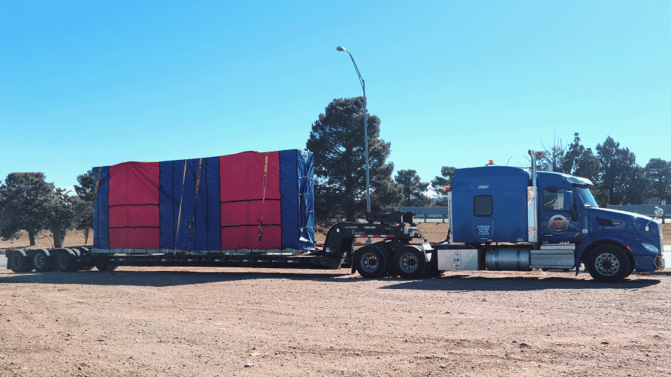
2. Tarping Provides Good Protection From the Elements
When properly deployed and secured, tarping flatbed and step-deck freight for short to medium lengths of haul can be very effective. Standard tarps — which are made from durable materials such as canvas and vinyl — are plenty capable of keeping rain, snow, wind and minor hail from reaching the commodities within them.
Additionally, tarps can be thrown onto products that are covered with shrinkwrap and those that are crated — creating another layer of weather-repellent protection.
As such, keeping products like structural lumber and steel, for example, dry during transport can be done by tarping them.
3. Tarping Can Be Used To Protect Over-Dimensional Freight
Products that don’t fit within the legal dimensional confines of a standard trailer — such as large machinery, generators or agricultural equipment — yet still require protection in transit, are often tarped.
Although standard tarps might not be big enough to cover these larger loads, there are some which are specially sized for this purpose.
Since there isn’t another option for protecting over-dimensional freight during over-the-road transport, tarps make their presence felt in this arena — helping over-dimensional shippers far and wide deliver products in good condition.
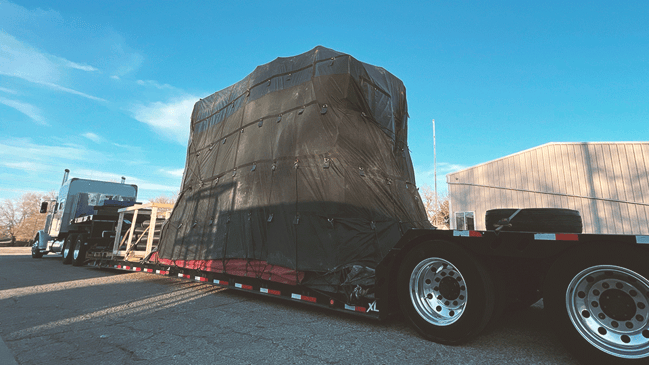
The Cons of Tarping Your Freight
Just like every rose has its thorn, there’s another side to the “tarping-your-freight” coin, some additional intricacies you should note. Like anything else, tarping your open-deck freight comes with a list of downsides, prime among them are:
- Tarping freight comes with a potential for cosmetic cargo damage.
- Tarping is less weatherproof than using a Conestoga.
- Tarping freight can stall your timelines.
1. Tarping Comes With a Potential For Cosmetic Cargo Damage
The thing about tarping your freight is that, similar to wearing a wool sweater without an undershirt, significant chaffing, rubbing and irritation can occur. When it comes to moving finished products, though, — products that have a fine layer of paint or coating — its condition upon arrival matters.
Tarping these loads can be dangerous as in-transit damage due to the tarp’s proximity to each product may occur. And, although shrink wrapping and padding can be added to cut down on touchpoints, tarping — by its very nature — leads to continuous, jostled contact.
As such, if you have sensitive freight to move, which could be significantly damaged by the repeated rubbing caused by a tarp or set of tarps, you may want to look elsewhere for a solution.
2. Tarping is Less Weatherproof Than Using a Conestoga
On longer-haul shipments, which still require protection from the elements just need to go further, the integrity of a set of tarps (no matter how well made) is put to the test.
Things happen all the time on these shipments; tarps come undone or shift, leaving spaces where freight is open to the elements. Although great drivers will stop off frequently to check and reposition tarps, it’s not uncommon for moisture to slip through, causing damage and leaving marks on tarped freight.
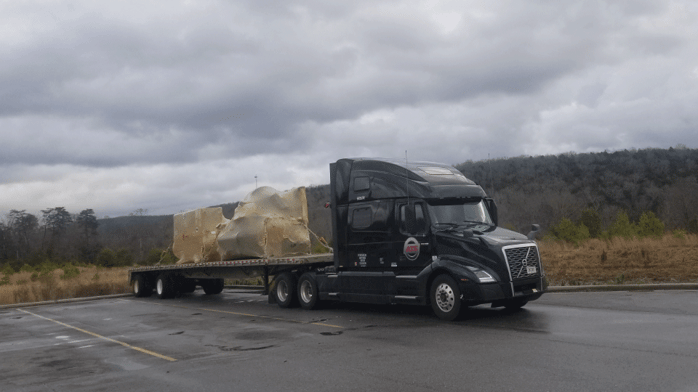
3. Tarping Freight Can Stall Your Timelines
Truck drivers are only legally allowed to perform their duties for 14 total hours (including 11 hours of driving time and 3 hours for resting) within a 24 hour period of time.
These hours of service (HOS), as they’re known, continuously run — beginning the moment they turn their truck on to start a shift.
Since truck drivers are legally limited to 14 hours of on-duty time, should tarping your load — which is both time-consuming (30 minutes or more) and physically demanding — set them back on their HOS clock they have no choice but to stop driving for 10 hours while their on-duty clock resets.
As you can imagine, a 10-hour delay on the front end of your shipment can significantly hinder your timelines and make it difficult to follow through on your commitments. For this reason, if you think tarping will be necessary for your load, offer to help drivers throw their tarps to ensure they leave your business with as much time remaining on their HOS as possible.
Additionally, it’s not unheard of for a driver to reject a load if he/she believes tarping it will damage his/her tarps. Tarps aren’t inexpensive to purchase (roughly $1,400 for a six-piece set) and drivers are usually required to purchase their own. If a driver shows up to haul your freight without knowing about its nature or jagged edges, you may be left without a solution as they opt out of hauling it.
The Pros of Using a Conestoga For Your Freight
Conestoga trailers come in a number of shapes and sizes, each suited for hauling different kinds of freight.
Although there isn’t a standard inside dimension for these trailers, most step-deck Conestogas offer shippers enough room to haul freight sizing up to 9 feet, 2 inches tall while lowboy Conestogas allow up to 11 feet, 7 inches of total cargo height.
With a use case grounded in helping businesses move their most sensitive products, the once-scarce Conestoga trailer has become increasingly abundant in recent years, positioning it among the most well-rounded transportation options in its class.
Related: What is a Conestoga Trailer?
However, like other trailer types and transportation options, using a Conestoga to transport your product(s) will leave you with a well-rounded list of pros and cons.
Let’s talk about some of them, beginning with the advantages of utilizing a Conestoga:
- Using a Conestoga reduces instances of cargo claims.
- Using a Conestoga offers enhanced weatherproofing.
- Using a Conestoga can increase your efficiency.
1. Using a Conestoga Reduces Instances of Claims
When loaded properly, a Conestoga’s sliding canvas system allows for the touch-free transportation of freight from A to B. Where tarping a freshly-painted load of steel handrails or a pristinely-finished industrial device may cause topical or even serious damage over time, all of this can be avoided with a Conestoga.
Simply load your freight from the side using a forklift or crane, allow your driver to properly secure it using straps or chains, slide the curtained tarp system back into place and hit the road.
There’s no need to worry about shrink wrapping or pad-protecting sensitive cargos within Conestogas. These trailers are designed to keep freight safe from precipitation and wind while cutting down on instances of cargo damage — and therefore claims — in the process.
2. Using a Conestoga Offers Enhanced Weatherproofing
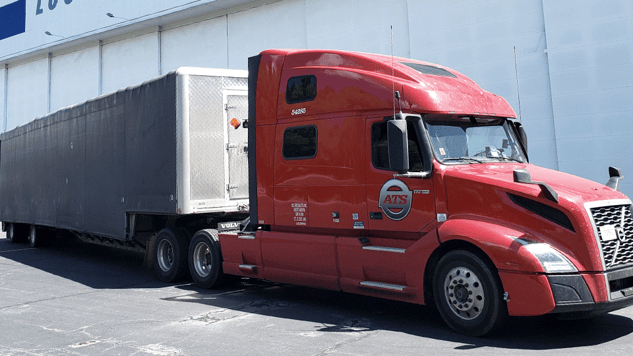
Conestogas are better at protecting freight from the elements than tarps or other solutions. By completely covering in-transit cargo in a 360-degree canvas box, Conestogas keep external elements where they belong; away from your load.
Compared to a Conestoga’s retractable system, simply tarping freight does a less-than-adequate job of stabbing off rain, snow, wind and hail — which can easily slip through holes or exposed areas to cause damage.
3. Using a Conestoga Can Increase Your Efficiency
This third advantage is rarely considered when shippers make their decisions on whether to use tarps or Conestogas for their shipments. You see — keeping in mind those hours of service that drivers must adhere to — Conestogas can be far more efficient than their alternative.
Instead of spending time throwing, positioning and securing tarps in a way that blocks out the elements, Conestoga drivers can spend more of their time hauling your freight.
In turn, provided you’re ready when a driver shows up to be loaded, you will see your supply chain’s efficiency increase as loading a Conestoga is just as easy as other open-deck trailers and allow you to avoid the time-consuming process of tarping.
The Cons of Using a Conestoga For Your Freight
What Conestogas offer shippers in terms of protection and efficiency, they give up in other ways. Due to their specialized nature and limited quantities, Conestogas might not fit your needs financially or otherwise. Let’s talk about why.
Here are the three largest disadvantages of using a Conestoga instead of tarping your freight:
- Conestogas offer limited cargo capacity.
- Utilizing a Conestoga will be more expensive than tarping.
- Conestoga drivers are more selective about the loads they move.
1. Conestogas Offer Limited Cargo Capacity
Unfortunately, the main strategic advantage a Conestoga trailer offers shippers (its retractable tarp system) also severely limits its capabilities. Unlike tarping an open-deck load — which gives shippers plenty of breathing room (especially with oversized permitting) — the products moved via Conestoga must fit within the dimensional confines of its enclosed walls.
For this reason, Conestoga trailers see their use-cases dissipate for larger (taller, wider, longer) loads.
2. Utilizing a Conestoga Will Be More Expensive Than Tarping
In the transportation industry, scarcity usually equates to increased pricing. Even though Conestoga trailers have become more common in recent years — as businesses worldwide recognize their value and trucking companies invest in them — they’re still a relatively rare trailer type (compared to traditional open-deck trailers).
As a result, if you’re hoping to secure the use of a Conestoga for your next shipment, expect to pay between 10-15 percent more than you would for a standard trailer.
This price hike, although possible to avoid, makes using a Conestoga trailer a bit more expensive than simply tarping your freight.
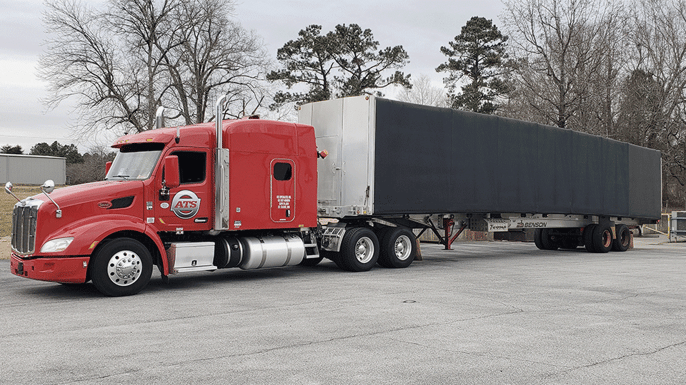
3. Conestoga Drivers Are More Selective With Their Loads
Because Conestogas are expensive to purchase — replacing the tarping mechanism alone can cost 15,000 dollars or more — those that own them are conscious about the freight they move.
For this reason, shipments that pose an imminent threat of ripping their canopy are likely to be avoided by Conestoga drivers. Although denial is unlikely after a truck has been dispatched — provided you’ve accurately supplied all pertinent load information — it’s possible that a driver may refuse your load should he/she feel uncomfortable moving it.
In turn, the delay this causes could disrupt your entire supply chain and make it difficult to meet demanding timelines.
Maintain Your Shipping Budget This Year
At the end of the day, the method you choose for protecting your freight during transit is up to you. As you now know, using tarps on an open-deck trailer can be easy on your bottom line while Conestoga trailers require a bit more capital to secure.
That said, Conestogas are really good at keeping the elements at bay and helping shippers move even the most sensitive of freight.
Honestly, to get your freight moved at the most competitive price point possible, you’ll be best served by keeping your options open and trusting your transportation provider. If they can provide a well-priced Conestoga solution, excellent. If not, tarping will do just fine.
Remember, though: the more options you grant your carrier, the better off you’ll be in the long run.
This isn’t the only thing that will help you save money, however. For some more tactics for reducing your freight costs by making your freight more appealing to truck drivers, download our comprehensive guide today.
By employing a few of these 12 tactics, you’ll have no trouble taking your transportation budget further in the days, weeks and months ahead.
